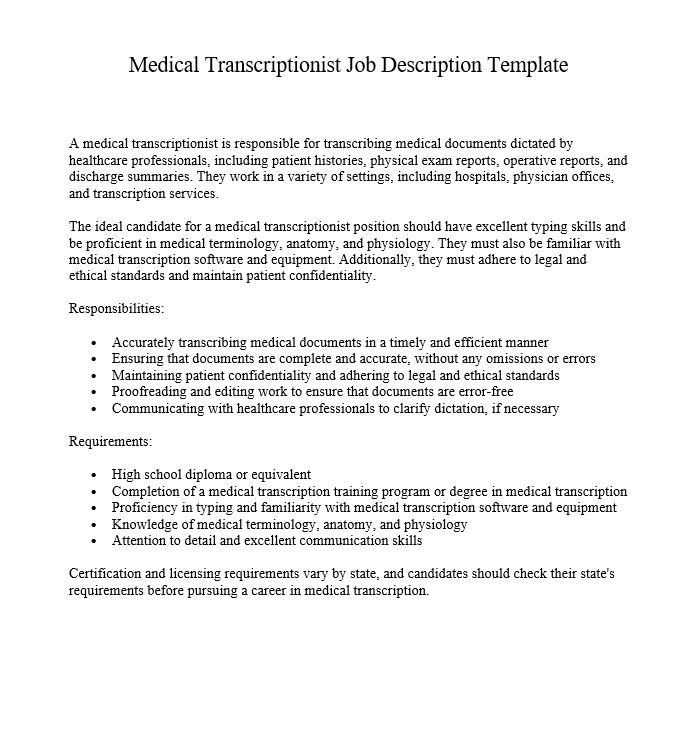The Role of Medical Transcriptionist Job Description in Healthcare
Medical transcriptionists are responsible for accurately transcribing medical documents in a timely and efficient manner. They work in a variety of settings, including hospitals, physician offices, and transcription services. Some of the documents they transcribe include medical reports, letters, medical records, and patient discharge summaries.

To accurately transcribe these documents, medical transcriptionists must have excellent typing skills and be proficient in medical terminology, anatomy, and physiology. They must also be familiar with medical transcription software and equipment. Additionally, they must adhere to legal and ethical standards and maintain patient confidentiality.
Medical Transcriptionist Responsibilities
The primary responsibility of a medical transcriptionist is to ensure the accurate transcription of medical documents. They must ensure that the documents are complete and accurate, without any omissions or errors. They must also maintain patient confidentiality and adhere to legal and ethical standards. Additionally, they must proofread and edit their work to ensure that the documents are error-free.
Medical Transcriptionist Requirements and Skills
To become a medical transcriptionist, individuals must have a high school diploma or equivalent. They must also complete a medical transcription training program or obtain a degree in medical transcription. Technical skills, such as typing proficiency, familiarity with medical transcription software and equipment, and knowledge of medical terminology, anatomy, and physiology, are essential. Soft skills, such as attention to detail, time management, and communication skills, are also important.
How to Become a Medical Transcriptionist
To become a medical transcriptionist, individuals can complete a medical transcription training program or obtain a degree in medical transcription. Certification and licensing requirements vary by state, and individuals should check their state’s requirements before pursuing a career in medical transcription.
The job outlook for medical transcriptionists is positive, with a projected job growth of 8% between 2020 and 2030. This growth is due to the increasing demand for healthcare services, which leads to a need for more medical documentation.
Medical Transcriptionist Job Description Template
A medical transcriptionist is responsible for transcribing medical documents dictated by healthcare professionals, including patient histories, physical exam reports, operative reports, and discharge summaries. They work in a variety of settings, including hospitals, physician offices, and transcription services.
The ideal candidate for a medical transcriptionist position should have excellent typing skills and be proficient in medical terminology, anatomy, and physiology. They must also be familiar with medical transcription software and equipment. Additionally, they must adhere to legal and ethical standards and maintain patient confidentiality.
Responsibilities:
- Accurately transcribing medical documents in a timely and efficient manner
- Ensuring that documents are complete and accurate, without any omissions or errors
- Maintaining patient confidentiality and adhering to legal and ethical standards
- Proofreading and editing work to ensure that documents are error-free
- Communicating with healthcare professionals to clarify dictation, if necessary
Requirements:
- High school diploma or equivalent
- Completion of a medical transcription training program or degree in medical transcription
- Proficiency in typing and familiarity with medical transcription software and equipment
- Knowledge of medical terminology, anatomy, and physiology
- Attention to detail and excellent communication skills
Certification and licensing requirements vary by state, and candidates should check their state’s requirements before pursuing a career in medical transcription.
Q: What is a medical transcriptionist?
A: A medical transcriptionist is responsible for transcribing medical documents dictated by healthcare professionals, including patient histories, physical exam reports, operative reports, and discharge summaries. They work in a variety of settings, including hospitals, physician offices, and transcription services.
Q: What are the responsibilities of a medical transcriptionist?
A: The primary responsibility of a medical transcriptionist is to ensure the accurate transcription of medical documents. They must ensure that the documents are complete and accurate, without any omissions or errors. They must also maintain patient confidentiality and adhere to legal and ethical standards. Additionally, they must proofread and edit their work to ensure that the documents are error-free.
Q: What skills are necessary to become a medical transcriptionist?
A: Technical skills, such as typing proficiency, familiarity with medical transcription software and equipment, and knowledge of medical terminology, anatomy, and physiology, are essential. Soft skills, such as attention to detail, time management, and communication skills, are also important.
Q: What education and training are required to become a medical transcriptionist?
A: Individuals must have a high school diploma or equivalent. They must also complete a medical transcription training program or obtain a degree in medical transcription.
Q: What is the job outlook for medical transcriptionists?
A: The job outlook for medical transcriptionists is positive, with a projected job growth of 8% between 2020 and 2030. This growth is due to the increasing demand for healthcare services, which leads to a need for more medical documentation.
Q: What certifications and licenses are required for medical transcriptionists?
A: Certification and licensing requirements vary by state, and individuals should check their state’s requirements before pursuing a career in medical transcription.
Q: What is the salary range for medical transcriptionists?
A: The median annual salary for medical transcriptionists is $34,770, according to the Bureau of Labor Statistics. However, salary may vary based on experience, location, and industry.
Q: What is the career path for medical transcriptionists?
A: Medical transcriptionists can advance to supervisory or management positions. They may also pursue further education and training to become medical coders or medical billers.